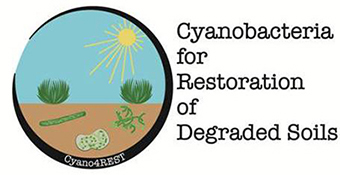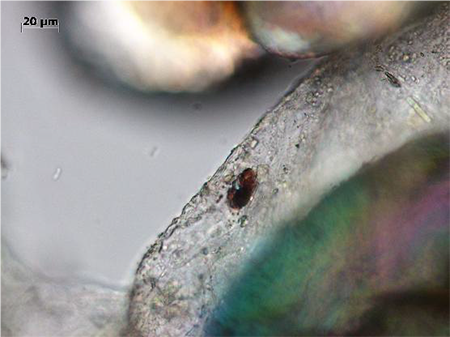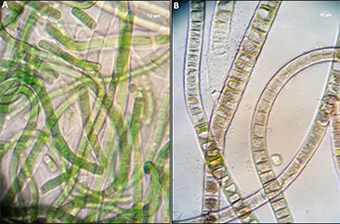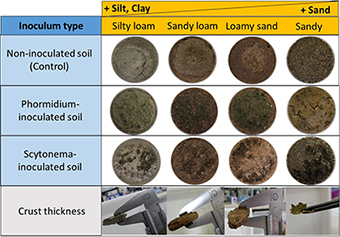Cyano4REST


Cyano4REST - Cyanobacteria for restoration of degraded soils
Project funded by the European Union’s Horizon 2020 research and innovation programme under the Marie Sklodowska-Curie Grant Agreement No. 706351
MSC Fellow: Dr. Sonia Chamizo de la Piedra - Supervisor: Prof. Roberto De Philippis
Introduction
Biocrusts: ecosystem engineers in drylands
Biocrusts are complex communities composed of cyanobacteria, algae, microfungi, lichens, mosses and other organisms in association with soil particles, which can cover between 40% and 100% of the soil surface in the intershrub spaces in drylands.
View of a semiarid landscape with biocrusts occupying the open spaces between plants
The crucial roles of biocrusts
- Soil stability: Biocrusts form a cohesive layer in the soil surface that strongly protects soils against water and wind erosion.
- Soil fertility: Biocrusts are able to fix the atmospheric carbon and nitrogen and release them into the soil, contributing to increasing organic matter and nutrient content.
- Soil hydrology: Biocrusts affect numerous soil properties that affect water retention and movement in soils.
- Plant establishment: Biocrusts improve the habitat for other microorganisms and for vascular vegetation
Cyanobacteria: a key component of biocrusts
Cyanobacteria , previously referred as blue-green microalgae, are prokaryotic oxygenic phototrophs found in almost every habitat on Earth. Cyanobacteria and the exopolysaccharides (EPS) they secrete play key roles in the environment.
- Cyanobacteria possess remarkable adaptations to combinations of stressful conditions such as extremes temperatures, high UV irradiance, drought and salinity.
- Unlike other organisms such as lichens or mosses, they can be easily isolated from soils and cultured ex-situ.
- Cyanobacteria release large amounts of EPS, creating a polysaccharidic matrix that plays a key role in the formation of biocrusts
Cyanobacterial polysaccharidic matrix
- Increases the soil organic carbon pool and stimulates exoenzyme activity that participates in the release of nutrients required by plants.
- Absorbs large amounts of water and significantly increases water uptake and retention of soils.
- Increases soil aggregation and porosity, favoring water infiltration.
- Cyanobacteria filaments and the sticky EPS increase soil aggregation and stability, improving soil resistance to wind and water erosion.
- Improves seed germination and plant growth and provides them with tolerance against biotic and abiotic stresses

Optical microscope image showing a sand grain covered by EPS (Mugnai et al. 2018, Biol Fertil Soils)
Cyanobacteria inoculation: a sustainable technique to combat land degradation
Dryland regions, which cover about 40% of Earth’s land surface and support over 1 billion people, are particularly vulnerable to land degradation processes caused by anthropogenic activities and impacts of climate change.
Soil degradation reduces the capability of soils to provide basic ecological services (water filtering and storage, substrate for living organisms, carbon and nitrogen cycling etc.) and to sequester CO2 and other greenhouse gases involved in global warming.
To mitigate on-going degradation processes in drylands, large scale and low-cost sustainable restoration strategies are required.
Cyanobacteria inoculation can be used as a restoration strategy to ameliorate degradation processes and contribute to maintaining of vital ecosystem services in drylands.
Aims of Cyano4REST
Cyano4REST was aimed at getting a better understanding of the relationships between the characteristics of the polysaccharidic matrix produced by different cyanobacteria strains (N-fixer and non N-fixer) and its role in affecting physico-chemical soil properties on different soil types.
The final goal of Cyano4REST is to develop an innovative methodology for recovering degraded soils by using environmentally-friendly exopolysaccharide (EPS)-producing cyanobacteria selected on the basis of their capability to affect water retention, CO2 fixation, soil structure and fertility in arid degraded soils.
To give answer to this general objective, four specific objectives were addressed in Cyano4REST:
- Objective 1. Identification of common cyanobacteria species present in biocrusts from semiarid regions.
- Objective 2. Chemical and macromolecular characterization of the EPS secreted by different cyanobacteria species in liquid culture and their effect on biocrust development, soil polysaccharidic matrix characteristics and soil properties change.
- Objective 3. Effect of cyanobacteria inoculation on soil properties related to soil stability and fertility in different textured soils, under laboratory conditions.
- Objective 4. Analysis of the influence of cyanobacteria inoculation on biocrust development and physico-chemical properties in arid soils under field conditions.
Main results obtained
- Soil inoculation with two cyanobacterial species (Phormidium ambiguum and Scytonema javanicum) led to rapid biocrust formation and improved soil stability and/or fertility properties on different soils.
- The positive effects greatly varied depending on species and soil characteristics, mainly soil texture. A thinner and more fragile biocrust developed in the sandy soil, while a more stable and resistant cyanobacterial biocrust developed in the finer soil textures.
- The two organisms had a different effect in the characteristics of the biocrust formed: one gave a stronger structure to the biocrust, while the other had a greater effect on photosynthetic biomass and soil nitrogen content.

Optical microscope images of the two selected strains: Phormidium ambiguum (A) and Scytonema javanicum (B)

Optical microscope images of the two selected strains: Phormidium ambiguum (A) and Scytonema javanicum (B)
Conclusions
The improvement in soil functions observed in the biocrusts obtained in this study suggests that the inoculation of EPS-producing cyanobacteria can be considered a promising sustainable technology to foster soil recovery in disturbed dryland soils.
The selection of cyanobacterial species to be used as soil inoculants based on their main functional roles and suitability for a given soil is an important issue to consider to maximize the positive effects on soil quality.
Dissemination activities
Papers (open source):
- Roncero-Ramos B., Muñoz-Martín, M.A., Chamizo, S., Fernández Valbuena L., Mendoza, D., Perona, E., Cantón, Y., Mateo, P. 2018. Polyphasic evaluation of key cyanobacteria in biocrusts from the most arid region in Europe. PeerJ 6:e6169. https://doi.org/10.7717/peerj.6169
- Chamizo, S., Mugnai, G., Rossi, F., Certini, G., De Philippis, R. 2018. Cyanobacteria inoculation improves soil stability and fertility on different textured soils: gaining insights for applicability in soil restoration. Frontiers in Environmental Science 6, 49. https://doi.org/10.3389/fenvs.2018.00049
- Chamizo, S., Adessi, A., Mugnai, G., Simiani, A., De Philippis, R. 2018. Soil type and cyanobacteria species influence the macromolecular and chemical characteristics of the polysaccharidic matrix in induced biocrusts. Microbial Ecology, https://doi.org/10.1007/s00248-018-1305-y
- Chamizo, S., Rodríguez-Caballero, E., Cantón, Y., De Philippis, R. 2018. Soil Inoculation with Cyanobacteria: Reviewing Its Potential for Agriculture Sustainability in Drylands. Agricultural Research & Technology 18(1): 556046. ISSN: 2471-6774 https://juniperpublishers.com/artoaj/volume18-issue1-artoaj.php
Participation in Congresses:
- Chamizo, S., Rodríguez-Caballero, E., Roncero-Ramos, B., Román, J.R., Domingo, F., Lázaro, R., Solé-Benet, A., Cantón, Y. 2019. Biocrusts as fundamental players in hydrological and erosion processes in drylands. International Symposium of GeoEcology and Desertification-from physical to human factors. Almeria, Spain, 20-22 February.
- Chamizo, S., Adessi, A., Nocentini, E., Certini, G., De Philippis, R. 2019. A sustainable approach for restoration of post-fire soils based on inoculation with cyanobacteria. International Symposium of GeoEcology and Desertification-from physical to human factors. Almeria, Spain, 20-22 February.
- Chamizo, S., Mugnai,G., Adessi, A., Simiani, A., Rossi, F., De Philippis, R. 2018. Soil restoration by cyanobacteria inoculation: relationship between cyanobacterial polysaccharidic matrix and soil properties. SER European Conference, Restoration in the Era of Climate Change. Reykjavík, Iceland 9-13 September.
- Chamizo, S., Mugnai, G., Rossi, F., Simiani, A., Adessi, A., De Philippis, R. 2018. Rehabilitation of arid soils by inoculating exopolysaccharide-producing cyanobacteria. Joint Conference EBC-VII & ISEB-2018. Crete, Greece, June 25-28. E-Book of Abstracts, p273.
- Chamizo, S., Mugnai, G., Rossi, F., Ciani, M., Pastacaldi, C., De Philippis, R. 2017. Increasing soil stability and fertility through cyanobacteria inoculation to combat land degradation processes in drylands. 6th International Conference on Drylands, Deserts & Desertification. Sede Boqer Campus, Israel, November 6-9.
- Chamizo, S., Mugnai, G.,Rossi F., Roncero-Ramos, B., Román, J.R., Rodríguez-Caballero, E., Cantón, Y., De Philippis, R. 2017. Inducing biocrust development by cyanobacteria inoculation to restore dryland ecosystems. VII World Conference on Ecological Restoration, SER 2017. Iguassu, Brasil, 27 August 27-1 September. Book of abstracts, p53.
- R. De Philippis, F. Rossi, G. Mugnai (2017) Rehabilitation of arid soils by inoculating exopolysaccharide-producing cyanobacteria: the role of the extracellular polysaccharidic matrix in the improvement of soil quality. VII World Conference on Ecological Restauration (SER2017), Foz do Iguassu, Brazil, August 26-September 1 2017; p. 5
- Chamizo, S., Román, J.R., Roncero-Ramos, B., Rodriguez-Caballero, E., Cantón, Y. 2017. Soil inoculation with cyanobacteria as a promising technique to combat degradation processes in drylands. Proceedings of the 1st World Conference on Soil and Water Conservation under Global Change-CONSOWA. Lleida, 12-16 June. p483-486.
- Mugnai, G., Rossi, F., Pastacaldi, C., Cangioli, L., Ciani, M., Berisha, B., Zhou, X., Chamizo, S., Chen, L., De Philippis, R. 2017. Inducing the formation of cyanobacterial crust by cyanobacterisation: elaboration and optimization of a proficient cyanobacteria inoculation methodology. 1st World Conference on Soil and Water Conservation under Global Change-CONSOWA. Lleida, Spain, 12-16 June.
- R. De Philippis, F. Rossi, T.L. Swenson, E. Couradeau, G. Mugnai, T.R. Northen (2017) Extracellular polymeric matrix in biocrusts: its role as a repository for essential exometabolites. Proceedings of the Congress Microbial Diversity (MD2017): Drivers of microbial diversity, Bari, Italy, 24-26 October 2017, pp 204-208
Other activities
- Presentation of the project at the European Researcher’s Night (Florence, 29.09.2017)
- Presentation of the project during the Summer School of the Master Course Biotechnology for environmental management and sustainable agriculture of the University of Florence (03.09.2018)
- Press release in the newsletter of “Accademia dei Georgofili” (07.11.2018)
Ultimo aggiornamento
21.10.2022
